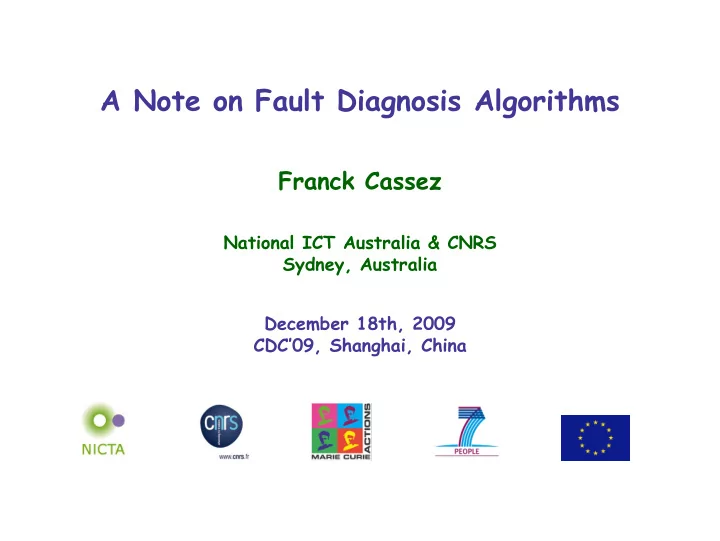

A Note on Fault Diagnosis Algorithms Franck Cassez National ICT Australia & CNRS Sydney, Australia December 18th, 2009 CDC’09, Shanghai, China
Fault Diagnosis for Discrete Event Systems a b ε f a Goal: detect a fault at most k steps after it occurred ε b Given: A finite automaton A over Σ ε,f = Σ ∪ { ε, f } f is the fault action, Σ is the set of observable events Define: Faulty ≥ k ( A ): k -faulty runs that contain f followed by ≥ k actions NonFaulty ( A ): Non faulty runs that contain no f Purpose of fault diagnosis: given k , and observable events Σ never raise an alarm on non-faulty runs always raise an alarm on k -faulty runs CDC’09, Shanghai (December 2009) A Note on Fault Diagnosis Algorithms 2 / 6
Fault Diagnosis for Dense-Time Systems a, x ≤ 3 ε f , x > 1 Goal: detect a fault at most ∆ time units after it occurred a, x ≤ 1 ε, x ≤ 1 ε Given: A timed automaton with continuous variables A over Σ ε,f = Σ ∪ { ε, f } f is the fault action, Σ is the set of observable events Define: Faulty ≥ ∆ ( A ): ∆ -faulty runs that contain f followed by ≥ ∆ time units NonFaulty ( A ): Non faulty runs (contain no f ) Purpose of fault diagnosis: given ∆ , and observable events Σ never raise an alarm on non-faulty runs always raise an alarm on ∆ -faulty runs CDC’09, Shanghai (December 2009) A Note on Fault Diagnosis Algorithms 3 / 6
Diagnosability Problem trace ( ρ ) = trace of the run ρ (a word in ( Σ ∪ { ε, f } ) ∗ ) π /Σ ( trace ( ρ )) = projection of the trace on observable events Definition ( k -diagnoser) A mapping D : Σ ∗ → { 0 , 1 } is a k -diagnoser for A if: for each run ρ ∈ NonFaulty ( A ), D ( π /Σ ( trace ( ρ ))) = 0; for each run ρ ∈ Faulty ≥ k ( A ), D ( π /Σ ( trace ( ρ ))) = 1. k -Diagnosability Problem Given A and k ∈ N , is there a k -diagnoser for A ? Diagnosability Problem Given A , is there a k ∈ N s.t. A is k -diagnosable ? Dense-time version defined using timed words, and timed languages CDC’09, Shanghai (December 2009) A Note on Fault Diagnosis Algorithms 4 / 6
Algorithms for Checking Diagnosability Necessary and Sufficient Condition for Diagnosability A is not diagnosable ⇐ ∀ k ∈ N ∗ , A is not k -diagnosable ⇒ Results for discrete event and dense-time systems Diagnosability reduces to checking Büchi emptiness Diagnosability reduces to bounded diagnosability (reachability) Complexity ∆ -Diagnosability Diagnosability Reachability Algorithm Büchi Emptiness Reachability PTIME PTIME PTIME DES O ( | A | 4 ) O ( | A | 2 ) O ( | A | 4 ) PSPACE-C. PSPACE-C. TA PSPACE-C. O ( | A | 2 ) O ( | A | 4 ) CDC’09, Shanghai (December 2009) A Note on Fault Diagnosis Algorithms 5 / 6
Consequences & Applications Easy proofs of existing results [Sampath et al., 95, Jiang et al., 2001, Yoo et al., 2002] Shows that Büchi based algorithms are better Use of standard model-checking tools for the diagnosability problem ◮ on-the-fly algorithms: SPIN, NuSMV ◮ efficient tools for timed systems: UPPAAL Expressive languages for specifying systems Selected References [Jiang et al., 2001] Shengbing Jiang, Zhongdong Huang, Vigyan Chandra, and Ratnesh Kumar. A polynomial algorithm for testing diagnosability of discrete event systems. IEEE Transactions on Automatic Control, 46(8), August 2001. [Sampath et al., 95] Meera Sampath, Raja Sengupta, Stephane Lafortune, Kasim Sinnamohideen, and Demosthenis C. Teneketzis. Diagnosability of discrete event systems. IEEE Transactions on Automatic Control, 40(9), September 1995. [Yoo et al., 2002] Yoo, T.-S., Lafortune, S. Polynomial-Time Verification of Diagnosability of Partially-Observed Discrete-Event Systems, IEEE Transactions on Automatic Control, 47(9), September 2002, 1491–1495. CDC’09, Shanghai (December 2009) A Note on Fault Diagnosis Algorithms 6 / 6
Recommend
More recommend